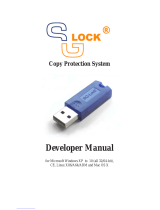
ReadiVoice v2.56.0 Release Notes 3725-70002-009G2
Polycom, Inc. Page 8 Confidential and Proprietary
MAPI EVENT Description
CURRENT_CONF_INFO2
This fix alters ACM MAPI clients that were receiving
CURRENT_CONF_INFO events: It adds a new XBOOL type and a
new CCI enum value to MAPI. If an ACM application was receiving
CURRENT_CONF_INFO before, its handler should be changed to
receive CURRENT_CONF_INFO2 (a child class of
CURRENT_CONF_INFO). In the handler changing the method:
void handle CURRENT_CONF_INFO (CURRENT_CONF_INFO
event) to handleCURRENT_CONF_INFO2
(CURRENT_CONF_INFO2 event) should be all the modification
needed (logic will still be the same as the #2 is a child of the
original).
CAPI Changes to address ACM
Billing Code requirements.
New event added has been added to XML API and CAPI:
SET_CONF_USER_DATA, also CONF_INFO now has a new field:
UserData. The functionality has been added to support future
development of ACM applications.
The change form ULONG -> LONG in RV2550 MAPI may have broken some customer's code. Because
LONG_TYPE was the base for both LONG and ULONG, Java could not auto cast between these types (UINT
as well). The problem has been corrected. ULONG now inherits from LONG instead of the common base
class LONG_TYPE. This allows Java to easily cast down the tree from ULONG to LONG to LONG_TYPE.
3.2 CAPI Changes
CAPI EVENT Description
ACM_CALL_ENTERED
ACM_CALL_ENTERED now has a PartType parameter to inform as
to the type of participant a channel is entering ACM.
PLAY_NAME
PLAY_NAME event now has a PartPlayTo parmeter that tells what
participant to play part(s) name(s) to (-1 == subscriber).
VALIDATE_MODERATOR_LOGIN
New event added: VALIDATE_MODERATOR_LOGIN to check
parameters that could be used in a moderator login and return a
matching subscriber ID in a SUBSCR_ID event, or NACK with a bad
login NACK reason. This should be of particular use to application
login type developers. Note: this is not a session event, no login
required of any type (see REQ_SYSTEM_INFO event for similar
behavior).
MessageSender interface
CastorMessageSender
MessageSender interface and CastorMessageSender changed to
add the extra PlayToPartId parameter (due to the limited scope of
usage of CAPI it was decided an interface change would not be
overly taxing to CAPI developers over having multiple playName
sender methods).
SET_CONF_USER_DATA
CONF_INFO
SET_CONF_USER_DATA event has been added to XML API and
CAPI. CONF_INFO now has a new field: UserData. The functionality
has been added to support future development of ACM applications.
CAPI Changes to address ACM
Billing Code requirements.
New event added has been added to XML API and CAPI:
SET_CONF_USER_DATA, also CONF_INFO now has a new field:
UserData. The functionality has been added to support future
development of ACM applications.























